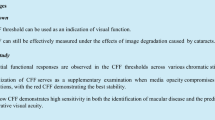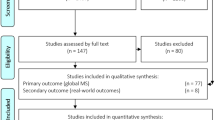Abstract
Purpose
To assess the influence of age-related macular degeneration (AMD) on critical flicker-fusion frequency (CFF).
Methods
CFF was measured centrally for a red, green and blue target, and in 10° excentricity with a red target. Twenty-eight patients with non-exsudative AMD, 12 patients with exsudative AMD and 45 age-matched healthy eyes were included.
Results
CFF decreased in eyes with non-exsudative AMD (red 1.3 Hz, p = 0.025; green 1.4 Hz, p = 0.053; blue 2.1 Hz, p = 0.006) and exsudative AMD (red 2.2 Hz, p = 0.02; green 3.3 Hz, p = 0.001; blue 2.9 Hz, p = 0.02). The difference between central and peripheral CFF increased in non-exsudative AMD (red–red 10°, 0.7 Hz, p = 0.024), but was not significantly increased in exsudative AMD (1.3 Hz, p = 0.059). There was no difference between eyes with non-exsudative AMD with good visual acuity (VA >20/32, n = 18) and healthy eyes, nor between eyes with non-exsudative (n = 10) and exsudative AMD (n = 9) with VA from 20/100 to 20/40.
Conclusions
CFF decreased in non-exsudative and exsudative AMD. CFF is not able to distinguish between AMD eyes and healthy eyes of equal visual acuity, and therefore is not applicable as a possible diagnostic test.


Similar content being viewed by others
References
Age-Related Eye Disease Study Research Group (2001) A randomized, placebo-controlled, clinical trial of high-dose supplementation with vitamins C and E, beta carotene and zinc for age-related macular degeneration and vision loss: AREDS report no. 8. Arch Ophthalmol 119:1417–1436
Curcio CA, Allen KA, Sloan KR, Lerea CL, Hurley JB, Klock IB, Milam AH (1997) Distribution and morphology of human cone photoreceptors stained with anti-blue opsin. J Comp Neurol 388:507–525
Curcio CA, Medeiros NE, Millican CL (1996) Photoreceptor loss in age-related macular degeneration. Invest Ophthalmol Vic Sci 37:1236–1249
Curcio CA, Sloan KR, Kalina RE, Hendrickson AE (1990) Human photoreceptor topography. J Comp Neurol 292:497–523
Eisner A, Klein ML, Zilis JD, Watkins MD (1992) Visual function and subsequent development of exudative age- related macualar degeneration. Invest Ophthalmol Vic Sci 33:3091–3102
Granit R, Harper P (1930) Comparative studies on the peripheral and central retina. II. Synaptic reactions in the eye. Am Physiol 95:211–228
Lachenmayr BJ, Gleissner M (1992) Flicker perimetry resists retinal image degradation. Invest Ophthalmol Vis Sci 33:3539–3542
Lachenmayr BJ, Kojetinsky S, Ostermaier N, Angstwurm K, Vivell PM, Schaumberger M (1994) The different effects of aging on normal sensitivity in flicker and light-sense perimetry. Invest Ophthalmol Vic Sci 35:2741–2748
Lovie-Kitchin J, Feigl B (2005) Assessment of age-related maculopathy using subjektive vision tests. Clin Exp Optom 88:292–303
Mayer MJ, Spiegler SJ, Ward B, Glucs A, Kim C (1992) Mid-frequency loss of foveal flicker sensitivity in early stages of age-related maculopathy. Invest Ophthalmol Vis Sci 33:3136–3142
Mayer MJ, Spiegler SJ, Ward B, Glucs A, Kim C (1992) Foveal flicker sensitivity discriminates ARM-risk from healthy eyes. Invest Ophthalmol Vis Sci 33:3143–3149
Michelson G, Patzelt A, Harazny J (2002) Flickering light increases retinal blood flow. Retina 3:336–343
Neetens A, Van den Ende P (1992) Foveal flicker-fusion frequencies: a simple, new apperatus (4F). Graefes Arch Clin Ophthalmol 230:358–361
Phipps JA, Dang TM, Vingrys AJ, Guymer RH (2004) Flicker perimetry losses in age-related macular degeneration. Invest Ophthalmol Vis Sci 45:3355–3360
Ronan S, Nusinowitz S, Swaroop A, Heckenlively JR (2006) Senile panretinal cone dysfunction in age-related macular dgeneration (AMD): a report of 52 AMD patients compared to age-matched controls. Trans Am Opthalmol Soc 104:232–240
Roorda A, Williams DR (1999) The arrangement of the three cone classes in the living human eye. Nature 397:520–522
Author information
Authors and Affiliations
Corresponding author
Additional information
All authors concur with the submission.
Rights and permissions
About this article
Cite this article
Maier, M., Groneberg, T., Specht, H. et al. Critical flicker-fusion frequency in age-related macular degeneration. Graefes Arch Clin Exp Ophthalmol 248, 409–413 (2010). https://doi.org/10.1007/s00417-009-1270-8
Received:
Revised:
Accepted:
Published:
Issue Date:
DOI: https://doi.org/10.1007/s00417-009-1270-8




